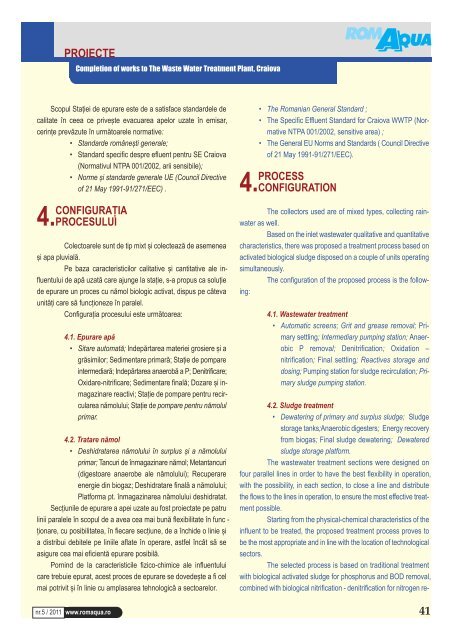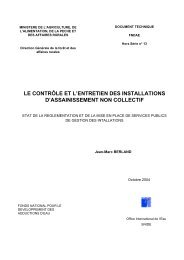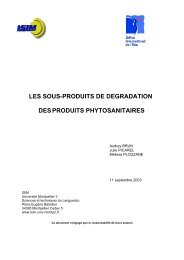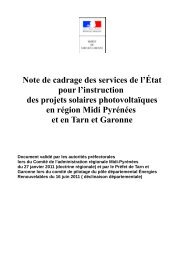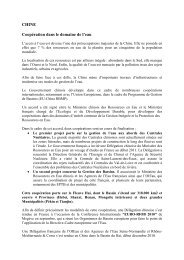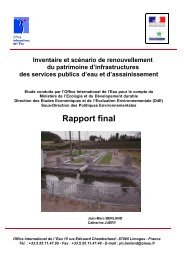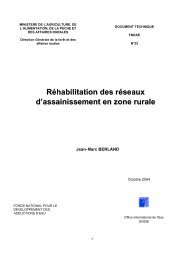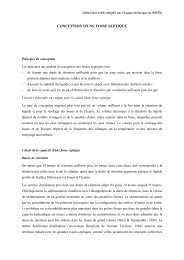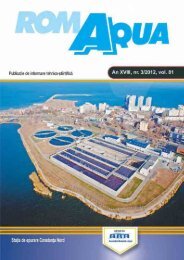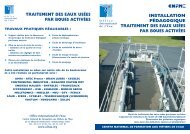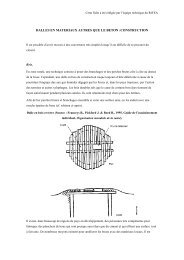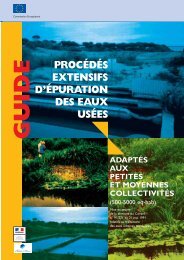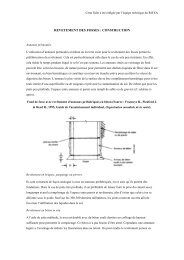vol 77 n° 5 2011 - Office International de l'Eau
vol 77 n° 5 2011 - Office International de l'Eau
vol 77 n° 5 2011 - Office International de l'Eau
You also want an ePaper? Increase the reach of your titles
YUMPU automatically turns print PDFs into web optimized ePapers that Google loves.
PROIECTE<br />
completion of works to the Waste Water treatment Plant, craiova<br />
Scopul Stației <strong>de</strong> epurare este <strong>de</strong> a satisface standar<strong>de</strong>le <strong>de</strong><br />
calitate în ceea ce privește evacuarea apelor uzate în emisar,<br />
cerințe prevăzute în următoarele normative:<br />
• Standar<strong>de</strong> românești generale;<br />
• Standard specific <strong>de</strong>spre efluent pentru SE Craiova<br />
(Normativul NTPA 001/2002, arii sensibile);<br />
• Norme și standar<strong>de</strong> generale UE (Council Directive<br />
of 21 May 1991-91/271/EEC) .<br />
4. CONFIGURAȚIA<br />
PROCESULUI<br />
Colectoarele sunt <strong>de</strong> tip mixt și colectează <strong>de</strong> asemenea<br />
și apa pluvială.<br />
Pe baza caracteristicilor calitative și cantitative ale influentului<br />
<strong>de</strong> apă uzată care ajunge la stație, s-a propus ca soluție<br />
<strong>de</strong> epurare un proces cu nămol biologic activat, dispus pe câteva<br />
unități care să funcționeze în paralel.<br />
Configurația procesului este următoarea:<br />
4.1. epurare apă<br />
• Sitare automată; In<strong>de</strong>părtarea materiei grosiere și a<br />
grăsimilor; Sedimentare primară; Stație <strong>de</strong> pompare<br />
intermediară; In<strong>de</strong>părtarea anaerobă a P; Denitrificare;<br />
Oxidare-nitrificare; Sedimentare finală; Dozare și inmagazinare<br />
reactivi; Stație <strong>de</strong> pompare pentru recircularea<br />
nămolului; Stație <strong>de</strong> pompare pentru nămolul<br />
primar.<br />
4.2. tratare nămol<br />
• Deshidratarea nămolului în surplus și a nămolului<br />
primar; Tancuri <strong>de</strong> înmagazinare nămol; Metantancuri<br />
(digestoare anaerobe ale nămolului); Recuperare<br />
energie din biogaz; Deshidratare finală a nămolului;<br />
Platforma pt. înmagazinarea nămolului <strong>de</strong>shidratat.<br />
Secțiunile <strong>de</strong> epurare a apei uzate au fost proiectate pe patru<br />
linii paralele în scopul <strong>de</strong> a avea cea mai bună flexibilitate în func -<br />
ționare, cu posibilitatea, în fiecare secțiune, <strong>de</strong> a închi<strong>de</strong> o linie și<br />
a distribui <strong>de</strong>bitele pe liniile aflate în operare, astfel încât să se<br />
asigure cea mai eficientă epurare posibilă.<br />
Pornind <strong>de</strong> la caracteristicile fizico-chimice ale influentului<br />
care trebuie epurat, acest proces <strong>de</strong> epurare se dove<strong>de</strong>ște a fi cel<br />
mai potrivit și în linie cu amplasarea tehnologică a sectoarelor.<br />
nr.5 / <strong>2011</strong> www.romaqua.ro<br />
• The Romanian General Standard ;<br />
• The Specific Effluent Standard for Craiova WWTP (Normative<br />
NTPA 001/2002, sensitive area) ;<br />
• The General EU Norms and Standards ( Council Directive<br />
of 21 May 1991-91/271/EEC).<br />
4. PROCESS<br />
CONFIGURATION<br />
The collectors used are of mixed types, collecting rainwater<br />
as well.<br />
Based on the inlet wastewater qualitative and quantitative<br />
characteristics, there was proposed a treatment process based on<br />
activated biological sludge disposed on a couple of units operating<br />
simultaneously.<br />
The configuration of the proposed process is the following:<br />
4.1. Wastewater treatment<br />
• Automatic screens; Grit and grease removal; Primary<br />
settling; Intermediary pumping station; Anaerobic<br />
P removal; Denitrification; Oxidation –<br />
nitrification; Final settling; Reactives storage and<br />
dosing; Pumping station for sludge recirculation; Primary<br />
sludge pumping station.<br />
4.2. Sludge treatment<br />
• Dewatering of primary and surplus sludge; Sludge<br />
storage tanks;Anaerobic digesters; Energy recovery<br />
from biogas; Final sludge <strong>de</strong>watering; Dewatered<br />
sludge storage platform.<br />
The wastewater treatment sections were <strong>de</strong>signed on<br />
four parallel lines in or<strong>de</strong>r to have the best flexibility in operation,<br />
with the possibility, in each section, to close a line and distribute<br />
the flows to the lines in operation, to ensure the most effective treatment<br />
possible.<br />
Starting from the physical-chemical characteristics of the<br />
influent to be treated, the proposed treatment process proves to<br />
be the most appropriate and in line with the location of technological<br />
sectors.<br />
The selected process is based on traditional treatment<br />
with biological activated sludge for phosphorus and BOD removal,<br />
combined with biological nitrification - <strong>de</strong>nitrification for nitrogen re-<br />
41


